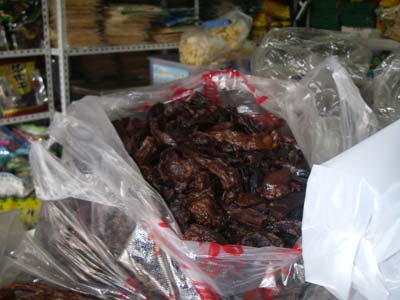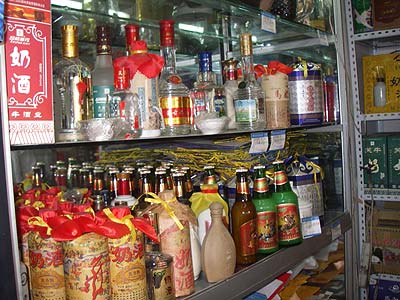In Hohhot, the capital of Inner Mongolia, the cuisine is as diverse as
the population. The city features several outstanding Chinese
restaurants, specializing in exotic South China dishes. These fancy
eateries are constructed to resemble giant indoor gardens, complete
with wild birds, fish and even an occasional alligator or two.
There are also dozens of motley fast food joints sprinkled around
the city serving both Chinese and Western dishes. And in the
various luxury hotels you can find a few expensive Western bistros
serving elegant continental cuisines. But people who come to Hohhot
invariably say that the distinct Mongolian cuisine is what most
appeals to their palates.
The primary purpose for food is nutrition, but it also has a
human dimension. Diners choose what they eat not only by flavor or
nutritional value but by cultural, religious, economic, status and
environmental factors. In Inner Mongolia for centuries the staple
traditional diet has been meat, milk and grain, mainly in flour
form. This is because Inner Mongolians were pastoral herders,
nomads who roamed freely on the vast grasslands, raising sheep,
goats, horses, yaks and camels. Only in the last sixty years have
they stopped wandering and settled down. Many now farm as well as
raise livestock; others have left for jobs in the big cities.
Additionally, in the early 1920s a great wave of Han Chinese
immigrated to Inner Mongolia, causing culinary as well as economic
changes. The Han people introduced diet variations among the Inner
Mongolians, the most notable being the addition of more fresh
fruits and vegetables. In the past people ate only a few native
plants: wild spring onions, wild lilies, wild apples and a few
herbs, such as thyme and lavender.
Today Chinese classify Mongolian food into several categories:
hong cai: red food -- meat; bai cai: white food -- dairy,
grains and/or bing -- pancakes and finally huo guo --
Mongolian hot pot. All of these types of foods originated hundreds
of years ago when the Mongolians led nomadic lives. In Hohhot there
is also a special dish called Shaomai -- a local but ancient
delicacy. This little flour pastry filled with minced lamb meat and
onions is said to have been created to feed a passing army that
arrived with very little notice. The dainty purses are fried on a
shallow pan and then served with Shanxi black vinegar.
Meat dishes:
The vast quantities of meat consumed here often shock visitors.
For Mongolians meat is hearty food that creates necessary energy to
fight off the long, cold winters. It is still the staple food in
Outer Mongolians. As herdsmen Mongolians have always valued meat.
Families consider their livestock animals as walking wealth and
walking food sources. Mongolians do eat beef but the cow is
considered more useful as a dairy source; mutton is the preferred
meat.
 |
Traditionally a lamb was ritually slaughtered during the New
Year and a red ribbon tied around his neck to commemorate the
holiday. Today at banquets visitors often are treated to a whole
roast lamb, called bukhel khoni. The meat entrée rests on a huge
platter; it is carried in by burly Mongolian waiters and then
deftly carved up. According to custom a small triangular slice from
the lamb's head is cut and thrown into the fire. For Mongolians
this action symbolizes the purity of fire and ensures that all the
guests will have good relationships with each other.
Some restaurants roast and then deep fry their lamb, adding to
its tenderness and texture. The cooking style is actually
Manchurian but it has been adopted by many Mongolians because it is
so delicious.
Borc shorlog is Mongolian Bar-B-Q: chunks of succulent roast
lamb are slathered with spices and then roasted on skewers until
done. You can find this on any street corner during a warm summer
night by simply following the aroma of roasting meat and cumin.
Shar luk consists of large chunks of lamb attached to bones
which are boiled and served up hot. Inner Mongolian chefs insist
that the meat be added to cold, unsalted water before the boiling
process begins in order to ensure a tender but hearty taste. Wild
onions and salt are later added to create stock.
Bordsom gedes are sausages made from horse meat, cow meat, or
camel meat.
Chutgasan gedes are sausages made from the meat and blood of
livestock animals.
Dairy dishes:
Milk, milk tea, milk wine, sour milk/yogurt, sour cream, cheese,
dried cheese and butter are all food products found here in Inner
Mongolia. Dairy foods are high in protein and minerals.
Traditionally Mongolians relied on them rather than on more
seasonable foods like vegetables and fruits. In the summer sour
milk products are thought to clean the stomach. Many Inner
Mongolians adhere to month long milk fasts in the summer. Dairy
products are thought to soften and whiten the skin; ladies apply
yogurt masks to their faces especially during the summer.
 |
Out of necessity Mongolians have found creative and ingenious
ways to use the milk of all five of the domestic animals in the
country: sheep, cattle, goats, camels and horses. Orom is the cream
that forms on top of boiled milk; it is highly prized and very
delicious. Airag is fermented mare's milk; it's a potent but
manageable wine. Nermel is a kind of home-brewed milk vodka that
resembles Chinese baijiu, very strong stuff. Tarag (Chinese suan
nai) is yogurt. Shar tos is a kind of ghee made from curds and
orom; it is sold in little glass jars labeled as "hwang yo" --
yellow oil. Today many delicious varieties of dairy products are
produced exclusively in Inner Mongolia at the Mengniu milk factory.
In some small home style cafes diners can find tsagaan tos, a
Mongolian porridge consisting of boiled cream mixed with flour and
natural fruits and a dried cheese called eesgii. Finally, there's
sgtai tse, or nai cha as the Chinese call Mongolian milk tea;
slightly salty but refreshing, this beverage is now sold everywhere
in dried form but of course it is best fresh.
Dried dairy products are also plentiful throughout Inner
Mongolia. Aaruul are dried curds. During the summer it can be seen
baking in the sun on top of Mongolian yurts in the Hulun Buir
grasslands in the far north. Eetsgii is a very hard, dried cheese.
Around Hohhot the Mongolian food stores also sell tofu block sized
pieces of cheese that somewhat resembles western cheese. It's
pungent and easily crumbles; this is bislag. These unique dairy
products are sold along with dried, seasoned jerky; Chinese: niu
rou gar. Jerky is made from cow, horse and camel meat.
Traditionally the Mongolians prepared dried foods to ensure
survival during the long winter months, now factories produce these
products for domestic and international consumption.
Grain and flour dishes:
Inner Mongolian cuisine isn't just about meat and milk: Inner
Mongolians also consume cereals, barley, potatoes, natural fruits
and plants native to the countryside. Wheat, oats, buckwheat and
millet are popular grains because these hardy plants grow on the
steppes and flourish in this cold, continental climate. In Hohhot
restaurants serve a very popular dish unique to this province
called "yo mian" -- it is made from both oats and/or buckwheat
flour, and served as a cold dish with cucumbers and sauce. In most
restaurants one may also order "wu wu" -- the term for oat
noodles rolled into little circles and cooked in a bamboo steamer.
Noodles here come in diverse shapes, from shells to fettuccini.
Potatoes also thrive in this chilly climate. Hohhot restaurants
serve a tasty cold dish made from cold mashed potatoes mixed with
baby wild onions.
Barley porridge can be eaten for breakfast or lunch but
traditionally Mongolians have uremtei khool: toasted millet mixed
with yogurt and/or sour cream, and then sprinkled with sugar.
Shar Bing: A large round flour pancake stuffed with minced meat
seasoned with garlic or onion (it can be anything from mutton to
beef to camel to horse) and fried on a grill.
Bansh: A dumpling like delicacy, mixed with minced meat and
onions or, it is covered with flour and steamed in boiling water.
It can also be fried in oil. This is very similar to the Chinese
jiaozi but much meatier.
Huo guo: Mongolian hot pot
Hot pot is known around China and the world. Fast, fun and
healthy, diners sit around a boiling cauldron of broth divided into
two parts: a bland soup and a spicy soup. Guests select from dozens
of foods: ranging from shaved lamb to chunks of fish, sliced root
vegetables and leafy greens, exotic innards, tofu and animal parts.
Everyone chooses something to add to the pot. The food quickly
cooks and diners enjoy reaching into the communal cauldron to
retrieve a delicious morsel. It is not hard to imagine nomads on
the steppe boiling up their dinner among friends as the stars
flicker gaily above them.
Eating out:
Mongolian restaurants crowd against each other along densely
populated side streets. To find them simply follow the aroma of
lamb wafting through the air. If you want a truly luxurious dining
experience, complete with Mongolian artifacts and a table in an
authentic Mengggubao (yurt) the Bai Yin Khor Va restaurant is not
to be missed. Bon appetite!
(China.org.cn by Valerie Sartor, July 23, 2007)